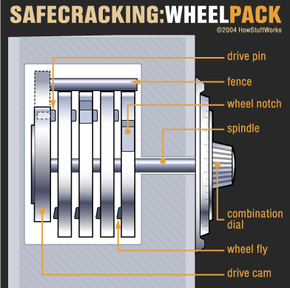Combination Locks
The combination lock remains the number-one method for securing a safe door. There are a variety of combination locks available. Combination locks for safes are divided into two classifications: Group 1 and Group 2.
Group 2 combination locks are the most common type found on home safes today. They provide one-, two-, or three-number combinations.
Advertisement
Group 1 locks provide a greater degree of protection as they can offer combinations of up to six numbers. These locks are also sturdier, and have more wheels in the lock mechanism. This greatly reduces the probability of even a skilled professional "cracking" the safe.
Now, let's take a look at what happens inside a combination lock.
The central lock feature in a combination safe is the wheel pack; a collective set of devices that work together to 'know' the combination. While safe manufactures have come up with several variations on the wheel pack to deter cracking, they are all designed around the same principle.
The wheel pack comprises a combination dial that is attached to a spindle. Inside the lock, the spindle runs through several wheels and a drive cam. The number of wheels in a wheel pack is determined by how many numbers are in the combination - one wheel for each number. When you turn the dial, the spindle turns the drive cam. Attached to the drive cam is a drive pin. As the cam turns, the drive pin eventually makes contact with a small tab on the adjacent wheel called the wheel fly.
Each wheel has a wheel fly on each of its sides. The drive pin spins the first wheel until it makes contact with the wheel adjacent to it. This continues until all the wheels are spinning. This is known as picking up the wheels. Each wheel on the spindle has a notch cut into it. When the right combination is dialed, all the wheels and their notches line up perfectly.
Resting just above the wheels is the fence. The fence is a small metal bar attached to a lever. The fence prevents the safe door from being opened without the combination being dialed. It does this by resting on the wheels and blocking the path of the bolt that secures the safe door.
When all the wheels line up, their notches align to form a gap. The fence falls into this gap under the force of its own weight. With the fence gone, the bolt can slide freely past and the safe can be opened.
When all the wheels in the wheel pack are in the correct position, their notches align to form a gap. Under the force of its own weight, the fence falls into the gap allowing the safe to be opened.
Though this design is relatively straightforward, it is mighty in its simplicity. The wheel pack design has been used for almost 100 years and still proves difficult to overcome for even the most skilled safecracker. But, it is not fool-proof. In the next sections we will take a look at the various ways safecrackers defeat this design.
